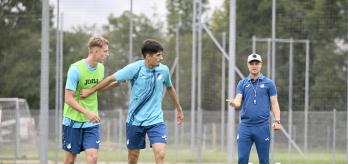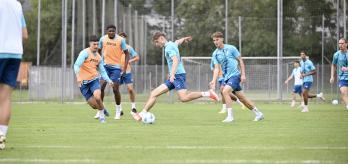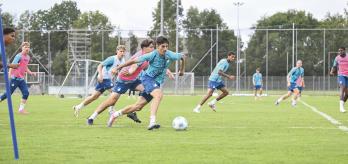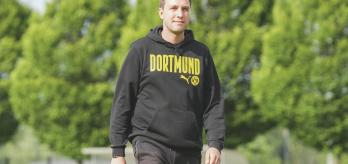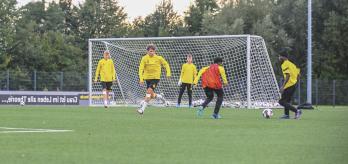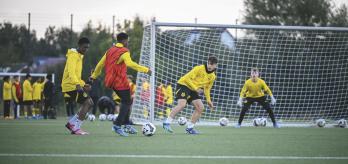The first exercise creates numerous 1v1 situations. As players work through the high-intensity drill, 3v2 scenarios emerge in front of goal. This exercise is followed by another that challenges teams to make the most of an extra player and exploit various overloads and transitions to create chances. In the next exercise, a 1v2 quickly turns into a 2v2, with the players starting from different points on the pitch. The last part of the session is devoted to a build-up exercise in which players are asked to create and exploit a 5v4 advantage in a tight space, which triggers numerous transition moments.
Fast and energetic transitions into 3v2
This exercise starts with various 1v1s, so intensity is guaranteed! On the coach’s signal, the players involved sprint around the poles as instructed, then play a 3v2 in front of a full-size goal.
-
In one half of the pitch, set up 1 goal with a goalkeeper. Then position a pole 3 metres to the left of the edge of the six-yard box, and another 3 metres to the right of the six-yard box. Finally, set up another 3 poles on the halfway line.
-
On the wings, mark out two 20m x 15m areas, each with a mini-goal at both ends, as shown.
-
Station a second goalkeeper next to the full-size goal with a supply of balls.
-
Form 2 teams and position the players according to their playing positions, as shown in the diagram:
-
Wingers at point A
-
Centre-backs and full-backs at point B
-
Strikers at point C
-
-
In each of the marked wing areas, play simultaneous 1v1s between the players that started at points A and B.
-
At the same time, the player at point C shoots at goal after being fed by the goalkeeper.
-
After 30 seconds, and when the coach makes the signal to do so, players A and C run round the poles at the halfway line, and B runs round the pole nearest to them in the penalty area.
-
The goalkeeper then kicks a high ball out to player C, and they attack the goal in a 3v2.
-
The offside rule should apply.
-
Then start again from the beginning.
Defensive 1v1:
-
The defenders should approach, set themselves, pick up the pace and force the attacker wide.
-
Players should react quickly to the coach’s signal, finish the move and switch as soon as possible.
-
All players should show maximum intensity when running around the poles.
Attacking 3v2:
-
The sequence should be completed as quickly as possible, because these situations only happen in transitions.
-
Both of the “A” players (wingers) should go out as wide as necessary.
-
The player in possession should run at the deeper of the two defenders to create a 2v1.
2v1+GK transitioning into 2+GKv3
The exercise starts with a 2v1+GK situation in front of a goal. Afterwards, the players involved need to transition immediately to join the two incoming players in a 2+GKv3 scenario to attack/defend a goal at the opposite end. The players in possession should look to exploit the overload as quickly as possible and get the ball towards goal.
-
On the wing, mark out a 35m x 15m area, and set up a goal (goal 1) with a goalkeeper as shown.
-
Then position another goalkeeper in the other goal (goal 2).
-
Form 2 teams and position them as shown in the diagram.
-
A coach should stand next to goal 1 with a supply of balls.
Sequence 1
-
Players A and B play a 2v1 against C in front of goal 1 until they get a shot away, the ball goes out of play, or they lose possession.
Sequence 2
-
Then the coach feeds the ball to the players running onto the pitch from deep.
-
The players involved in the 2v1+GK follow behind them.
-
They play a 3v2+GK in front of goal 2.
-
The offside rule should apply.
-
Then start again.
Creating and exploiting a 2v1+GK:
-
The player in possession dribbles towards the defender. Just before they get there, they play a square ball to their team-mate.
-
All the players should immediately shift into a sprint.
Attacking 3v2:
-
Players A and C should go out as wide as necessary.
-
A 2v1 can be created by the ball carrier dribbling towards the deeper defender (if the ball is in a central area) or by the other player running alongside their team-mate (on the flanks).
Defending:
- Players should develop the strong determination to defend to the maximum of their ability, even when outnumbered or in a bad position.
Defending from different angles
In this drill, you have to ensure that the player making the initial pass actually does it properly. If you do not have three goalkeepers and three full-size goals, you can replace the goals for counter-attacks with mini-goals or youth-sized goals.
-
Set up 1 full-size goal on the goal line. Then set up 2 more goals at an angle 30 metres from the goal line (towards the halfway line) as shown, and position a goalkeeper in each of the 3 goals.
-
Place 3 poles outside the penalty area (5 metres from the edge of the penalty area), 20 metres apart.
-
Form 2 teams and position them as shown in the diagram.
-
Player A passes to player C, and immediately puts them under pressure.
-
Player C gets moving as fast as possible and plays 1v2 against players A and B in front of goal 1.
-
If they win the ball, the defenders can counter-attack towards goal 2 or 3.
-
After a goal is scored or the ball goes out of play, the coach passes D.
-
It becomes a 2v2 in front of goal 1.
-
The offside rule should apply.
-
If they win the ball, the defenders can counter-attack towards goal 2 or 3.
-
A and B then change roles.
-
Start the next run-through from a wide position, and so on.
-
After a while, repeat the drill starting from the other wing.
-
1v1 in the middle: The defender should approach, set themselves, pick up the pace and force the attacker onto their weaker foot.
-
2v2: Defenders should block off the middle, force the attacker wide and create a 1v1.
-
Instil a mindset of always defending the goal, regardless of the circumstances.
-
1v1 After receiving the ball, the player should get moving straight away and drive towards goal.
-
2v2: A 2v1 can be created by the ball carrier dribbling towards the deeper defender (if the ball is in a central area) or by the other player running alongside their team-mate (on the wing).
5v4 build-up in tight spaces
Borussia Dortmund run this drill regularly, because it is a realistic way of practising build-up play, and the small playing area is deliberately designed to challenge the players. Players make a lot of errors and they are punished immediately. The exercise also generates plenty of transitions; to cope with them, you need to press quickly and have a good resting defence. It is really difficult to react quickly, but it is doable if the players furthest away from the ball stay alert and drop in at the right moments. Borussia usually have a lot of possession and often end up playing against opposition who sit deep and lurk on the counter. That is why the resting defence is such an important part of their game.
-
Mark out a hexagonal playing area (longest side: 25m, shortest side: 20m). Then set up 1 full-size goal (with a goalkeeper) and 2 mini-goals, as shown in the illustration.
-
Form a blue team of 5 “attackers“ and a red team of 4 “defenders“.
-
The blues should set up in a 4-1 formation, with the reds in a 2-2 shape.
-
The ball starts with the goalkeeper. Once the goalkeeper plays the ball out, play 5v4, with the team of 5 attacking the mini-goals.
-
The offside rule should not apply.
-
If they win the ball, the defenders should counter-attack towards the full-size goal.
-
Play should always restart from the goalkeeper.
-
Constant preparation is key.
-
Passing should be sharp and accurate to make it possible to progress attacks.
-
The defensive midfielder (in the number 6 role) in the central area should play between the lines and force the defenders to close ranks. That in turn frees up space for the wing-backs.
-
The wing-backs should push up right onto the last line of defence and force them to fall back, which makes it harder to stay compact. It also forces the frontline to retreat, which creates space for the central defenders.



